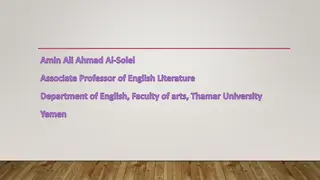Mastering Story Structure for Academic Writing Success
Discover the key elements of story structure for academic writing success in this seminar presentation. Learn how to craft compelling narratives for your papers and proposals by understanding the OCAR framework - Opening, Challenge, Action, and Resolution. Get valuable insights from "Writing Science: How to Write Papers That Get Cited and Proposals That Get Funded" by Joshua Schimel.
Download Presentation

Please find below an Image/Link to download the presentation.
The content on the website is provided AS IS for your information and personal use only. It may not be sold, licensed, or shared on other websites without obtaining consent from the author.If you encounter any issues during the download, it is possible that the publisher has removed the file from their server.
You are allowed to download the files provided on this website for personal or commercial use, subject to the condition that they are used lawfully. All files are the property of their respective owners.
The content on the website is provided AS IS for your information and personal use only. It may not be sold, licensed, or shared on other websites without obtaining consent from the author.
E N D
Presentation Transcript
Graduate Seminar ENVR 6111
Writing Science: How to Write Papers That Get Cited and Proposals That Get Funded. Schimel, Joshua. Oxford University Press, USA, 2012. Online textbook (free to read online through WT University System). PDF will be accessible through the course page on WTClass.
Chapter 4 Story Structure Basic Science Elements = OCAR, Opening - Challenge - Action - Resolution
Chapter 4 Story Structure Basic Science Elements = OCAR, Opening - Challenge - Action - Resolution
Chapter 4: Story structures These slides were prepared by Sylvie No l with minor modifications for CS by D. Avis https://www.slideshare.net/SylvieNol
From Writing Science: How to Write Papers That Get Cited and Proposals That Get Funded, Joshua Schimel, 2011
The elements of a storys structure Opening (O) Challenge (C) Action (A) Resolution (R)
Opening Who are the characters, including the main character the story is about? Where does the story take place? What do you need to understand to follow the story? What is the larger problem being addressed?
Challenge What are your characters trying to accomplish? What specific question are you trying to answer?
Action What happens to address the challenge? What work did you do or are proposing to do (for a proposal)?
Resolution Extremely important Show how your work has changed our understanding of the world Map back your resolution to your opening It must say something about the larger problem you identified there Your conclusion should address a topic as wide as your opening
Four core story structures OCAR Slowest, takes time to work into the story ABDCE Faster, starts in the action LD Faster yet LDR Fastest with the whole story up front
OCAR Opening Challenge Action Resolution Typical of science papers Challenge is at the end of the introduction Resolution comes at the conclusion
ABDCE Action Starts with dramatic action to immediately engage readers Background Describe characters and setting so that readers can understand the story Development Follow the action as the story develops to the climax
ABDCE Climax Bring all the threads of the story together and address them Ending Same as resolution: what happened to the characters after the climax? Typical of modern fiction and scientific proposals
A good story is circular Typical of OCAR and ABDCE structures By the end, we are back at the beginning But things have changed, and we need to highlight how they have changed
LD Lead/Development or the inverted pyramid of news stories Core of the story is in the first sentence (lead) Rest of the story fills out the story (development) In LD, the lead collapses opening, challenge and resolution into a single short section (as short as a sentence).
LDR Lead/Development and Resolution Typical of magazine articles The lead must be engaging, but the resolution is left for the end, to entice the reader to go to the end
Story structure in science writing Scientific paper: OCAR O: opening is larger problem and central characters C: challenge is interesting question A: action is research plan and results R: resolution is conclusion about how our understanding about the world has changed as a result of the work
Story structure in science writing Generalist journals (Nature, Science): LDR Editors are professionals, not scientists Structure should be similar to other magazines Start with a strong lead to interest the editors
Story structure in science writing Proposals: LDR or ABDCE Your proposal must convince reviewers that the topic identified in the opening is important It must fill them with excitement at the questions posed in the challenge If it has not done so within the first two pages, you will lose your audience and not get funded























